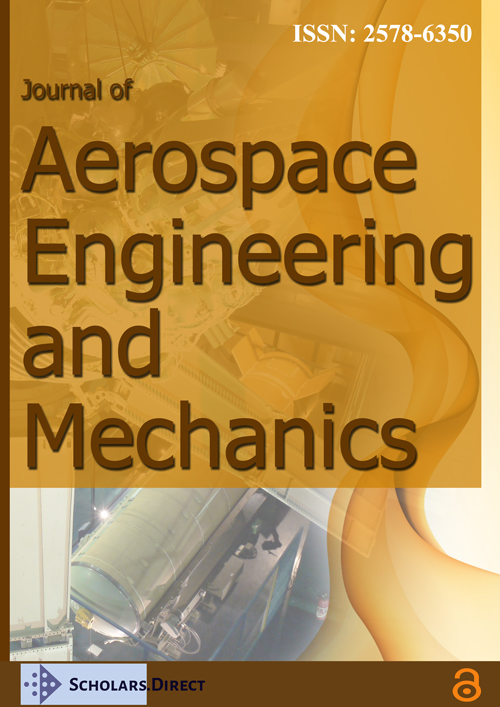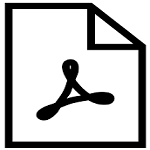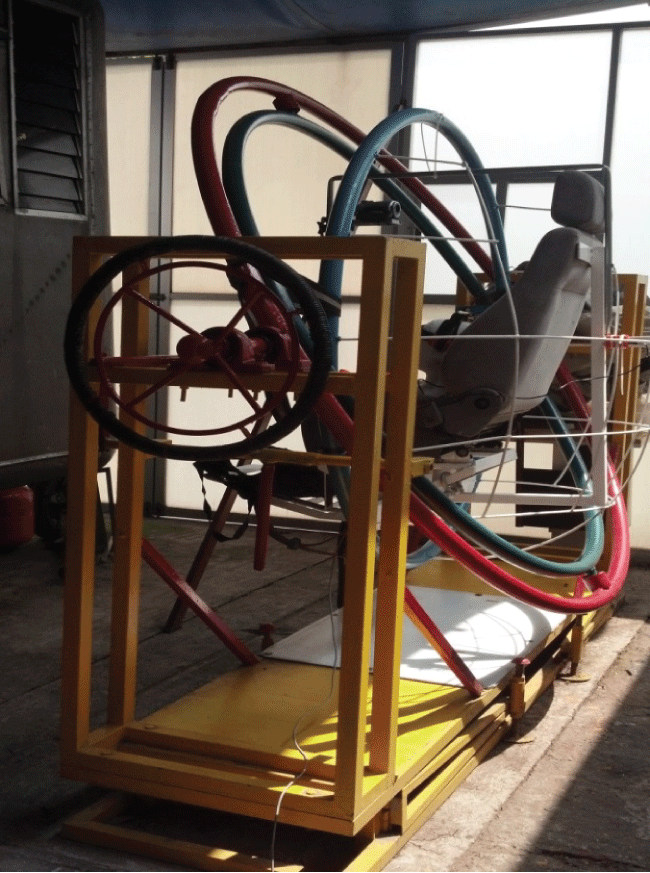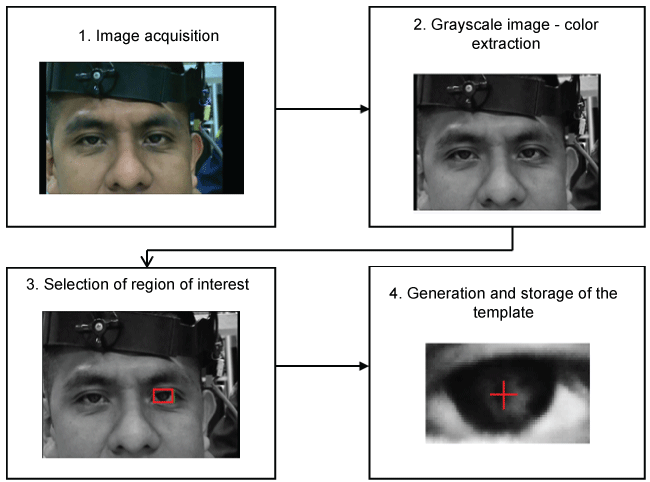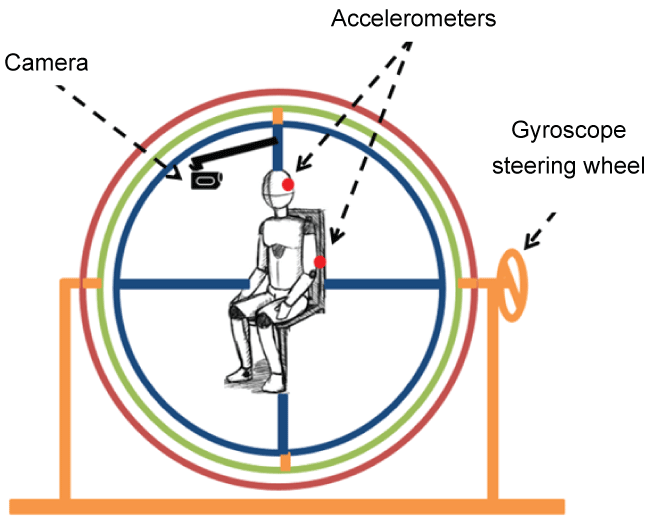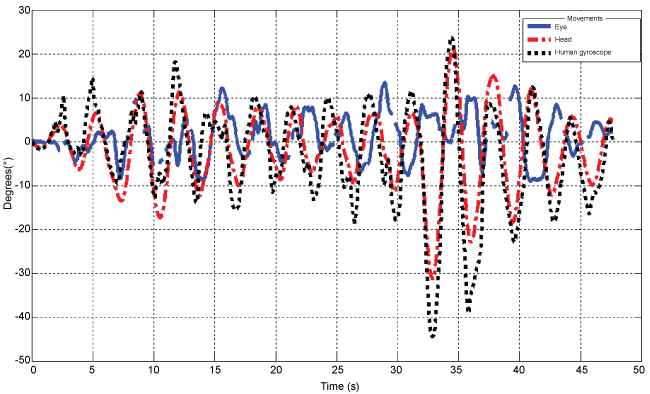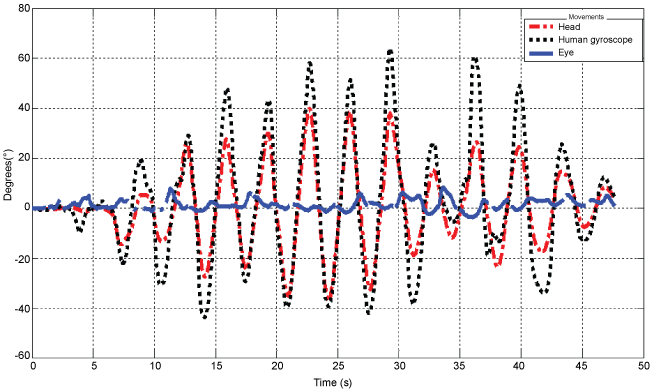Instrumental Methodology for the Study of Vestibule-Ocular Reflex Associated to Spatial Disorientation Induced by Random Movements of a Human Gyroscope
Abstract
The present methodology describes a register system of ocular and head movements in a human gyroscope, whose purpose was to observe the behavior of the vestibulo-ocular reflex. Two stages compound the system: a video-oculography element, which quantifies eye movements; the second element consists in an array of two 3-axis accelerometers disposed in the human gyroscope (for reference) whereas the other one is attached to the head of the subject (with aid of a helmet). The results showed that it was possible to detect eye and head movements without restriction in the movement of the human body, which is very useful for the detection of problems associated with loss of balance and spatial disorientation.
Keywords
Human gyroscope, Accelerometers, Vestibulo-ocular reflex, Loss of balance, Spatial disorientation
Introduction
The incorrect appreciation of position, movement, or orientation in the three planes of space is what is known as spatial disorientation. Three systems, as a whole, are responsible for human spatial orientation: the visual system, vestibular system and proprioceptive system [1,2].
Under normal flight conditions, when there are visual references on the horizon and ground, the sensory system of the inner ear allows to identify the movements of pitch, roll and yaw in the aircraft, but when the visual signals are lost, vestibular illusions (somatogyral-semicircular canals, these include the Leans, the Graveyard Spin and Spiral, and the Coriolis Illusion.) can occur that represent a risk to the operation of the aircraft [1].
The eye is a highly reliable orientation mechanism when it has the appropriate reference points. However, under certain conditions, for example for a pilot in flight, it may become difficult to interpret the visual signals. Disorientation in flight is considered as an important source of perception errors in aeronautical medicine. A common way to induce vestibular reflexes is through the natural movements of the head while the subject focuses the gaze on a target (Vestibule-ocular reflex - VOR) [3,4].
In order to study the vestibulo-ocular reflex, parameters such as the velocity of eye movements, which are coordinated with the movements of the head, are usually analyzed. When the gaze is fixed on an object and the head moves in any direction, there is a compensation movement that rotates the eyes in the opposite direction to the head but with the same magnitude, allowing focus the gaze on the object that deserves attention, despite the rapid movements of the head and the human body. Linear and angular VORs (lVORs and VORs) are examples of compensatory responses. The VOR compensates by producing angular eye velocity that opposes angular head velocity. The lVOR compensates by rotating the eyes to maintain gaze on specific space-fixed targets when subjects are translated laterally or vertically with the head fixed [3-6]. Eye movements may be influenced by stimulation of the vestibular system, but also by visual inputs, proprioceptive signals from the neck, and the cervico-ocular reflex (COR) which is an ocular stabilization reflex that is produced by rotation of the neck and works in conjunction with the VOR. The vestibular nuclei are located within the medulla and pons of the brainstem which interprets the signals as movement [7-9].
The International Civil Aviation Organization (ICAO) recommends that pilots be tested to determine whether or not there are problems in the subject related to the vestibular system (e.g. the ability to walk a straight line). In case of irregular vestibular test results, the pilot should be referred for further evaluation using more sophisticated test methods, for which it is commonly used to evaluate the responses of vestibulo-ocular reflexes [3]. VOR responses are commonly studied for the detection of different pathologies related to the vestibular system, such as loss of balance, balance, posture and gait [10].
The gain of the vestibulo-ocular reflex is defined as the change in the angle of the eye divided by the change in the angle of the head during the rotational movement of the eye [11]. Ideally the gain of the VOR is 1.0. The gain of the horizontal and vertical VOR is usually close to one, but the gain of the torsional VOR (rotation around the line of sight) is generally low. The low gain is attributed to the torsional rotation of the head produces little displacement of the retina near the fovea therefore; little compensatory movement of the eye is needed. The gain of the VOR adapts to different circumstances, for example, in light or in darkness. Sometimes it can be greater than 1, which means that the eyes move more (in degrees) than the head. At other times the gain can be less than 1, when the gaze fixed on the visual objective and the head move with the same velocity and direction. Cancellation of the VOR occurs during voluntary shifts in gaze that are accompanied by head movements. The gain is a useful parameter to detect some abnormalities (but not the only one) in the vestibular system as well as response velocities since it is considered that for a clear vision the movement of the head should be compensated almost immediately [12,13].
To detect eye movements, a particularly useful solution consists in video-oculography (VOG) which is a non-invasive technique composed of image processing algorithms employed to measure the position of the pupil [14-16]. The study of head movements takes on importance when we talk about the relationship between these and the vestibulo-ocular reflex, or between the head-neck [17].
An alternative method is presented to evaluate vestibulo-ocular reflex for a person who does not have a benchmark where it is necessary to perform complementary tests, and they may include different types of movements and are not limited the movements present in the human body, movements that can be related to the pitch, roll and yaw in an aircraft. Especially for pilots who perform acrobatic flights, where the speed of response must be high.
This work present a proposal for the study of the vestibular system which allows to perform tests with no restriction in the movements of the human body (especially body pitch movements), allowing the movements performed during the tests to represent a scenario closer to that experienced by a pilot in flight, and then, be able to study their ability to compensate for movements, keeping a record of movements in order to relate the movements of the head, human body and eye. In addition, by the proposed system it is possible to obtain the velocity of all these movements, thus allowing the identification of the response rate of the vestibulo-ocular reflex in people.
Materials and Methods
To address the problem, it was proposed to use accelerometers and VOG to record the movements. Accelerometers were used for recording movements of the head and human gyroscope. Two accelerometers (Xsens - MTi) were used, one of them attached to a helmet that was placed on the head and the other on the human gyroscope. For the recording of eye movements, video-oculography techniques were used. A general block of the proposed system is shown in Figure 1.
The accelerometers used for the detection of movements were integrated by a gyroscopic sensor, which made it possible to obtain a better tracking of the movements and through the software "MT Software Suite", data such as acceleration, position and corresponding graphics could be recorded in order to obtain the VOR gain. The accelerometer used in the human gyroscope was placed to have a reference of the random movements.
For the case of eye movements, the Sony DCR Handycam video camera was used, which has the capacity to capture 30 frames per second (Fps). The camera was placed in such a way that at all times it recorded the movements made during the test. The final assembly is shown in Figure 2 and Figure 3.
For the image processing a program was performed in Labview, which is divided into two parts, the first part allows to select the template that will be used to monitor the movements of the eyeball, the second part will track and store the images Data obtained for further processing in Matlab. In Figure 4 is presented a general block diagram of the program that allows generating the template for tracking movements.
After generating the template, we proceeded to process the video for recording the movements. Figure 5 exhibits a general block diagram of the program that tracks and stores the position of the eyeballs.
Frame by frame was acquired in Lab view and then, with the help of the IMAQ vision library of Lab view the color of the image was extracted for later using NI Lab VIEW software and Vision Development Module to develop an automatic eye detection system that can run on any standard computer system without additional hardware requirements.
Five different templates were used to follow the eye, which were created by the IMAQ Construct ROI in lab view, allowing focus on the region of interest (ROI) in each subject's eye. The first template corresponded to the gaze in the primary position of the subject; the other templates corresponded to the secondary positions of the gaze: supraversion, infraversion, dextroversion and levoversion.
The program developed in Lab view allowed to register the position in pixels of the eye and as it was known the distance to which the camera was placed (30 cm) it was possible to obtain the angle of displacement starting from the primary position of the subject's gaze.
Tests
For tests performed on the human gyroscope, a video camera was mounted in front of the subject to record eye movements, an accelerometer on a helmet was placed on the subject's head to record the movements of the head and another accelerometer was placed behind the subject to detect the movements made by the human gyroscope in which the subject was sitting. The tests were performed in the light, without fixing the subject's head.
The tests consisted in making random movements of the human gyroscope while recording the movements made by the subject, without having to fix the gaze at some point. In Figure 6 is shown the final assembly for performing the tests on the gyroscope, as well as the placement of the sensors. The random movements were performed by a person who assisted in the tests and manipulated the steering wheel of the human gyroscope.
Results
VOR was present in both directions (horizontal and vertical) and was simultaneity recorded during the tests in the human gyroscope, where there was no restriction in body movements. Results are shown in Figure 7 (horizontal direction) and In Figure 8 (vertical direction).
The mean gain of the vestibulo-ocular reflex was 0.48 and the average gain of the head-to-body ratio (gyroscope) was 1.36. The mean gain of the vestibulo-ocular reflex was 1.24 and the average gain of the head-to-body ratio (gyroscope) was 0.42.
In Figure 9 and Figure 10 are shown two more records of the same test performed on a different subject, mentioning their mean vestibulo-ocular reflex gain and head-body (gyroscope) gain.
The mean gain of the vestibulo-ocular reflex was 1.02 and the average gain of the head-to-body ratio (gyroscope) was 0.70. The mean gain of the vestibulo-ocular reflex was 2.92 and the average gain of the head-to-body ratio (gyroscope) was 0.30.
According to the figures shown above, the data obtained can be summarized in Table 1.
Discussion
The ideal gain is 1, however, if the gain is above 1, the eye moves faster than the head, and the correction shafts will be directed in the same direction as the head rotation. If the gain is below 1, the eye will move more slowly than the head, and the correction shafts will be directed in the opposite direction to the turning of the head.
According to the above, it is observed that the gain of the vertical VOR tends to be greater than the gain of the horizontal VOR, this because in the gyroscope movements can be made that allow to incline the body from front to back, thus affecting the vertical responses. In addition, the gain of the head-to-body ratio tends to be closer to the value of 1 in the horizontal than in the vertical responses.
On the other hand, in some graphs a slight signal offset can be observed because the vestibulo-ocular reflex response is not immediate but it is considered that the higher the response speed the better the stabilization of the gaze will be the subject. From the graphs (Figure 7, Figure 8, Figure 9 and Figure 10) is observable that there is a delay in the performance of the VOR probably because the visco inertial dynamics of head and neck muscles are different from the visco elastic dynamics of eye and extraocular muscles, the saccade is over before head position has changed.
In the graphs where the vertical movements are shown, the ocular movements appear to be poor; this can be due to the body being more accustomed to respond to stimuli or perturbations in the horizontal plane than in the vertical, reason why the movements of compensation do not manifest as much as in the graphs of horizontal movements.
In other works where eye and head movements have been recorded [18-20], body movements are limited. With the instrumental methodology used it is shown that it is possible to perform tests without restriction in the movements of the body through the use of the gyroscope (especially body pitch movements), in addition, the camera and accelerometers can be adapted to different scenarios according to the tests that may be required. It is necessary to mention that the limitation in the movements of the body does not mean something negative. These tests can supplement information obtained from tests where the movement of the human body is limited. Besides allowing studying the reflexes under different scenarios, for example, in random movements in 3D and controlled movements.
Conclusions
With aid of VOG and accelerometers; eye, head and human body movements can be detected by synchronizing the recording times of the head, eyes and human gyroscope. In addition, due to the developed graphical interface, the data obtained to determine the angles of the head and eye positions could be processed. With these data it was possible to graph the responses that were obtained in the different tests performed to finally analyze them and relate them to the vestibulo-ocular reflex.
Variations obtained in gains are associated to movements during the tests, which were considered completely random, then, there are moments where vestibulo-ocular reflex did not appear (as it was shown in Figure 7, Figure 8, Figure 9 and Figure 10), specifically where the movements of the head and eye exhibit the same direction.
The results show that it is possible to detect eye and head movements without restriction in the movement of the body by means of accelerometers and the use of camcorders, especially for cases in which it is required to perform random movements or when there is no reference point, For example for a pilot in flight who has no reference other than aircraft instruments, tests and records that can be of great help in areas such as aeronautical medicine, to observe the responses of vestibulo-ocular reflex in pilots.
Although the presented data are variable, the responses obtained from the VOR are very similar to those of other studies, which means, the opposite direction of the head and eye movements can be observed although the amplitude is not the same due to the Movement of the body during the performance of the tests.
The processing of the records can be used for early detection of the presence of different pathologies such as disorientation in space, involuntary movements, posture, gait and loss of balance.
References
- Federal Aviation Administration (2016) Aeromedical Factors. Pilot's Handbook of Aeronautical Knowledge, United States Department of Transportation, Oklahoma, USA.
- Linda W Pauwels, Elizabeth J Akesson, Patricia A Stewart (1988) Cranial nerves, anatomy and clinical comments. B.C. Decker Inc, USA.
- International Civil Aviation Organization-ICAO (2012) Manual of Civil Aviation Medicine. (3rd edn), Quebec, Canada.
- Wolfgang H Zangemeister, HC Hansen (1987) Fixation suppression of the vestibular ocular reflex and head movement corre-lated EEG potentials. In: JK O'Regan, A Levy-Schoen, Eye Movements from Physiology to Cognition. Elsevier Science, North-Holland, Netherlands.
- M Rodenburg (1987) "Coordination of head and eye position during fixation." In: Eye Movements from Physiology to Cognition. 211-218.
- Imai T, Moore ST, Raphan T, et al. (2001) Interaction of the body, head, and eyes during walking and turning. Exp Brain Res 136: 1-18.
- Volpe, Nicholas J (2004) "Adler's Physiology of the eye, clinical application". (10th edn), Mosby Company, USA.
- Gabriel M Gauthier, L Stark (1987) Adaptive Optimization of eye-head coordination with degraded vision. In: JK O'Regan and A Lévy-Schoen, Eye movements: from Physiology to Cognition. Elsevier Science Publishers BV, 201-210.
- WPA Kelders, GJ Kleinrensink, JN Vander Geest, et al. (2003) Compensatory increase of the cervico-ocular reflex with age in healthy humans. J Physiol 553: 311-317.
- Srulijes K, Mack DJ, Klenk J, et al. (2015) Association between vestibulo-ocular reflex suppression, balance, gait, and fall risk in ageing and neurodegenerative disease: protocol of a one-year prospective follow-up study. BMC Neurology 15: 192.
- Marc D Binder, Nobutaka Hirokawa, Uwe Windhorst (2009) Encyclopedia of Neuroscience. Springer, Washington, USA.
- Peggy Mason (2011) "Medical Neurobiology". (2nd edn), Oxford University Press, New York.
- Arthur Guyton, John Hall (2005) Cortical and Brain Stem Control of Motor Function Motor Cortex and Corticospinal Tract. In: William Schmitt, Rebecca Gruliow, "Textbook of Medical Physiology". (11th edn), Elsevier Saunders, Philadelphia, Pennsylvania.
- Fabiola M Villalobos-Castaldi, Ernesto Suaste-Gómez (2013) A new spontaneous pupillary oscillation-based verification system. Expert Systems with Applications 40: 5352-5362.
- Ernesto Suaste Gómez, Anabel S Sánchez Sánchez (2012) "Biomedical instrumentation to analyze pupillary responses in white-chromatic stimulation and its influence on diagnosis and surgical evaluation." In: Radovan Hudak, Marek Penhaker, Jaroslav Majernik Biomedical Engineering - Technical Applications in Medicine, Intech Open minds.
- E Suaste-Gómez, R Mora-Martínez, E Villarreal-Calva, et al. (2014) "Instrumental Methodology for the measurment of the pupil cycle time using a chromatic slit lamp". IFMBE Proceedings 49: 20-22.
- L Stark, WH Zangemeister, S Lehman (1981) Simulation of Head Movement Trajectories: Model and Fit to Main Sequence. Biological Cybernetics 41: 19-32.
- Imai T, Moore ST, Raphan T, et al. (2001) Interaction of the body, head, and eyes during walking and turning. Exp Brain Res 136: 1-18.
- Roberto Panichi, Botti FM, Faralli M, et al. (2011) Self-motion perception and vestibulo-ocular reflex during whole body yaw rotation in standing subjects: The role of head position and neck proprioception. Human Movement Science 30: 314-332.
- Mark Walker, Liao K (2011) The human translational vestibulo-ocular reflex in response to complex motion. Ann N Y Acad Sci 1233: 242-248.
Corresponding Author
Geovanny Palomino Roldán and Ernesto Suaste Gómez, Departamento de Ingeniería Eléctrica, Sección de Bioelectrónica, México.
Copyright
© 2017 Roldán GP, et al. This is an open-access article distributed under the terms of the Creative Commons Attribution License, which permits unrestricted use, distribution, and reproduction in any medium, provided the original author and source are credited.

